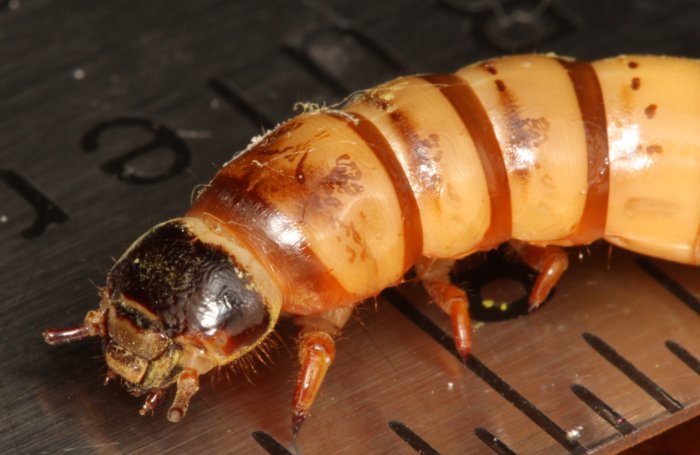Superworms
Back in June of 2015, we went to the local cricket dealer to get crickets to feed to our tarantulas. Now, just selling crickets is no way to make a living, the demand just isn’t there, so she was also selling a variety of other things for people to feed to their carnivorous pets. One of those items that caught Sam and Rosie’s eyes were these Superworms (Zophobas morio), which are really big beetle larvae. As you can see by comparing this one with the ruler, it is well over an inch long.
They are pretty much your classic “generally tubular eating machine” type of larva, with just enough armor that you can handle them without much danger of squashing them. They make pretty good pets as they don’t require much water. We just kept them in a small transparent box with oatmeal for food, and the occasional apple core for moisture. Although, we did find that it is necessary to replace the apple cores every day or two, otherwise everything gets pretty moldy.
The superworms have your typical detrivore mouth, and will eat most anything. Although, their lack of pickiness can be a problem – if their food gets moldy, they will eat it anyway, and apparently mold is a bit toxic.
We started with a dozen superworms, but by the time June 26 rolled around, we were down to four. The losses were partly due to a mold episode, but the bigger problem was that, when one of them got ready to pupate, the others would notice that it was defenseless and would kill and eat it. Not cool, guys. So, at that point we put the last four into individual jars instead of a community aquarium (and Rosie promptly named them Ben, Jane, JoJo, and Tarzan). Once they were isolated from one another, they successfully pupated.
Like a lot of beetle pupae, they show pretty well-defined heads, antennae, and legs, rather than being nearly featureless blobs like moth and fly pupae.
About two weeks after pupating, the adults emerged. Initially, they were practically white.
After exposure to air, though, their exoskeletons hardened and darkened, starting with the legs and antennae. First they turned reddish-brown,
and then ultimately almost jet-black.
After becoming adults, they still ate the same things as the larvae had (oatmeal and apple cores), and they lived a long time. The two that ultimately survived to adulthood ended up living until nearly Christmas, so their adult lifespan is around 5 months. We didn’t get any eggs, most likely because our two were not a male/female pair, so we had to stop at this point. But still, as pet insects go, these are pretty good. The larvae are long-lived, durable, and amusingly squirmy, and the adults are happy to crawl around on childrens’ hands without biting. And they are cheap to raise, too.
Comments are closed.








It would be interesting to have an inset on each photo showing the surviving population from a single laying of eggs at that stage. For example, it might go:
20,000
10,000
8,000
2,000
…
Are they just an extra large breed of mealworms or are they a separate species? (Oh and I’ve been reading this page for years, and it’s great.)
They are a separate species. The ancestral Superworms are a tropical species from South America. The regular, much smaller “Mealworms” are Tenebrio molitor, and grow up into beetles like these.
Although, I understand that there is another kind of mealworm on the market, the “Giant Mealworms”, that is actually derived from Tenebrio molitor mealworms. They are treated with a juvenile hormone so that they never mature, but just keep getting bigger and bigger.
I do hope that for some strange reason this was an experiment to see how long these were able to live in mouldy circumstances?
In my opinion this is no way to treat any living creature. I have to deal with feeder insects including mealworms now and again, and I don’t know how you could go near them in spite of anything else, because they stink when they are not looked after.
You don’t just let them rot in their own filth. They are so easy to look after and any sign of mould is a sign they are not being looked after properly. Yes I’ve left the odd bit of food in now and again, but I remove all the mouldy area and usually put the worms in new oatmeal. They should be put in new oatmeal when they’ve eaten through most of the old stuff anyway. A good pointer for that is as soon as they start to smell.!
Seeing your photos with black mould – that should never happen! I can only hope you look after the crickets better and don’t feed your Ts crickets that are living in mouldy conditions.